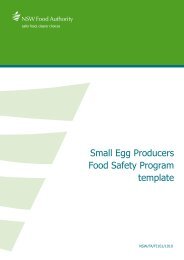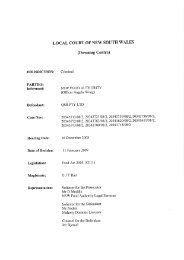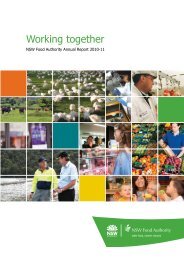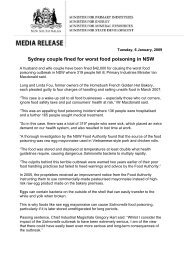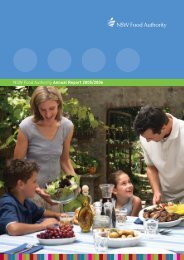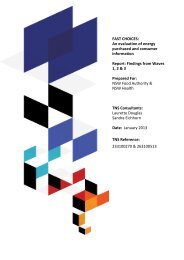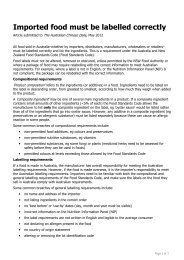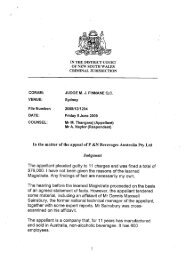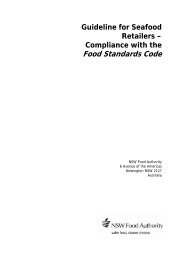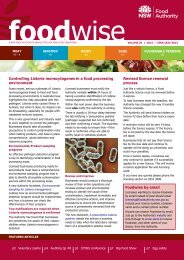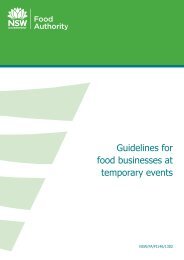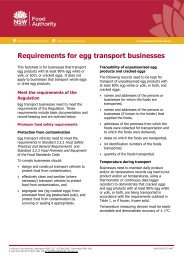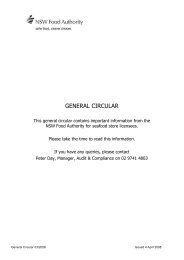Foodwise Spring 2010 | Volume 20a - NSW Food Authority
Foodwise Spring 2010 | Volume 20a - NSW Food Authority
Foodwise Spring 2010 | Volume 20a - NSW Food Authority
Create successful ePaper yourself
Turn your PDF publications into a flip-book with our unique Google optimized e-Paper software.
foodwiseA <strong>NSW</strong> FOOD AUTHORITY NEWSLETTER FOR <strong>NSW</strong> FOOD INDUSTRIESvolume <strong>20a</strong> | spring <strong>2010</strong> | ISSN 1833-2013MeatP3SeafoodP5Dairyp6Poultry and eggsP7vulnerable personsp8Duping customers costs food seller close to $26,000On 30 April 2009, a <strong>NSW</strong> <strong>Food</strong> <strong>Authority</strong>authorised officer visited a growers’ marketwhich had an agreement with the localcouncil that only locally grown producecould be sold there. On sale were bunchesof asparagus, displayed as locally grown.The officer then visited a retail store runby the same food business that had thestall. This store advertised that it soldlocal produce. There was asparagus theredisplayed as ‘Product of Australia’.Investigation by the very diligent officerfound that the asparagus sold at bothlocations had, in fact, been grown in Peru.The company was subsequently issuedwith three Penalty Notices. Two related tothe sale of food that was falsely described,and one for engaging in conduct likely tomislead or deceive, because ‘Product ofPeru’ tags had been removed from theasparagus before it was displayed for sale.Generally, the <strong>Authority</strong> does not issueDisplay licensing label or risk a fineWhen a licensee is granted a licence, theywill receive a certificate of licence fromthe <strong>Authority</strong>. Businesses must displaythis certificate at each facility wherethe business is run. However it can beimpractical for a food transport vehicle orfishing vessel to do this.To make this easier, the <strong>Authority</strong> issuesan adhesive licensing label for vehicles andvessels that it licenses. The label must beattached in a prominent position to thevehicle or fishing vessel.Recent compliance inspections conductedby the <strong>Authority</strong> found that many foodpenalty notices straight off. It will usuallyissue a warning letter or improvementnotice to give the business an opportunityto rectify the situation. However, inthis case the business was aware of itsobligations. All stall-holders at the growers’market had received advice about foodlabelling, including country of originlabelling, and this particular food businesshad previously received a warning letterabout the need to notify the <strong>Authority</strong> oftheir market stall.The matter could have ended with thebusiness operators had not affixed thelabel to their vehicle or vessel, or stilldisplayed an expired label.<strong>Food</strong> business operators who do notdisplay the current label on their vehicleare at risk of enforcement action under<strong>Food</strong> Regulation <strong>2010</strong>. The current fine forfailing to display a licensing label is $330.Labels are colour coded by yearJust like an RTA vehicle registration sticker,these labels come in a different coloureach year (the <strong>2010</strong> label is light blue).Labels also have the date of expiry andvehicle registration number printed onbusiness paying the Penalty Notices;however it elected that the noticesproceed to Court. As a result, the <strong>Authority</strong>continued its investigation, and chargedthe food business with these offences:• Engaging in conduct that is misleadingor deceptive: for the removal of ‘Productof Peru’ labelling (two charges)• Displaying for sale Peruvian asparagusfalsely described as ‘locally grown’ and‘Australian’ (two charges)• Failure to notify the <strong>Authority</strong> of a foodbusiness: regarding the market stall• Removing part of the label on theasparagus product without permissionThe Court convicted and fined thecompany $1000 for each one of the sixoffences. In acknowledging the additionalwork the <strong>Authority</strong> had to undertake toprepare the matter for Court, the <strong>Authority</strong>was awarded $19,990.21 in costs—the fullamount claimed by the <strong>Authority</strong>.them.If you don’t have a current licensing labelfor your vehicle or vessel, contact the<strong>Authority</strong>’s Helpline. They can check thestatus of the licence for a vehicle andarrange for a new label to be sent out.featured articlesp3 Beef labelling Billp4 Licenseeinterviewp5 Kalang update p7 Egg scheme in p7 Fee waiver
Seafood and shellfish4High demand for consistent quality drives expansion of food safety practicesOriginally an egg business in the 1970s,Australian owned Tuscany <strong>Food</strong>s is now alarge food manufacturing company thatvalue adds to a wide range of egg, dairyand other products which find their wayinto muffins, cakes, pizzas, pies, soups andother goodies.‘In the mid-1990s we identified the bakeryfood industry as a viable partner for valueadded products,’ said CEO Ben Bouchet.Pasteurised egg pulp was soon followedby a range of food ingredient productstargeting the bakery sector.Block cheese is cut, shredded then automaticallyweighed and packed into a modified atmosphere bagFurther expansion of its integratedmanufacturing operations into a full rangeof value added ingredient type productsnow sees the company selling to majorfood manufacturers across the foodservice, industrial, retail and QSR (QuickService Restaurants) market sectors acrossAustralia and even overseas.‘The food manufacturing industrydemands convenience and good serviceat a competitive price,’ Ben said, ‘butincreasingly, and perhaps even morestrongly, it demands products of a high,consistent, dependable quality.Meat Industry Consultative Committee report August <strong>2010</strong>The Federal government, through theDepartment of Agriculture, Fisheries &Forestry (DAFF), has allocated $400,000to a re-education program for thegame meat industry since the lossof the Russian market last year. Freerefresher training courses are being run.All licensees harvesting kangaroo meatfor human consumption need to do thistraining to be able to renew their licence.The <strong>Authority</strong> was pleased with theattendance at the Listeria summit heldin July, and with the quality of speakersand presentations. The international guestspeakers toured some processing facilities‘Meeting this demand, and operating safelyand in an environmentally friendly manner,is very important to the business,’ Benstated.Rigorous approach to food safetyTuscany <strong>Food</strong>s was HACCP certifiedin 1995. With the development ofTuscany <strong>Food</strong>s’ other manufacturingfacilities over the past 15 years, their<strong>Food</strong> Safety Program was expandedand certified across all three facilities.Today, the company has a full timeQuality Assurance team dedicated tocontinuous improvement, training, andpromoting their <strong>Food</strong> Safety Program to allemployees.Ben is a strong believer in involving allemployees in food safety awareness andtraining. ‘When we see something thatisn’t quite right we use it as an opportunityto call staff together to explain how itneeds improving,’ Ben explained. ‘Thisgives staff the chance to ask questions andreceive clear instruction at a very practicallevel, which results in good learningoutcomes.’This shop floor training supplementsthe company’s formal in-house, andconsultant-delivered HACCP training.Even with meticulous systems inplace, Ben believes it is important forsomeone outside the business to checkon food safety systems. He sees the<strong>Authority</strong> as having a crucial role inmonitoring compliance to regulation andhelping manufacturers with direction tocompliance.As a local business with numerousmanufacturing facilities, Ben said a majorand Dr John Butts of Land O’Frost USA wasvery impressed with the risk assessmentwork being undertaken here. Membersreceived a CD of all presentations givenat the Summit. A survey of attendeesprovided good feedback from industry andsome suggestions of possible topics forfuture events. There had been exceptionalindustry response to this summit.A note of thanks was sent to the AustralianMeat Industry Council, MLA and the ACMFInc for their help in funding the event.The <strong>Authority</strong> tabled a press releasefrom the Minister and draft copies oflicensee storyissue relating to food safety is the numberof different standards their business hasto comply with, and the time and costinvolved to formally comply. The holygrail would be one standard, one audit, tosatisfy the whole food industry.People are becoming ever more aware offood safety, and Ben said that—especiallyover the past five or so years—hiscustomers have become increasinglyvigilant in their requirements fordocumentation on food safety controls inthe business. ‘And I suppose we’ve donethe same with our suppliers’, said Ben.‘We have an approved supplier program toensure we only buy from businesses withsimilarly strict standards to ourselves.’The end result is an industry thatcustomers have a lot of confidence in.Liquid chocolate is deposited into buttonsBen believes their integration from farmingto value adding in the egg industry, andtheir partnering strategy with suppliersand customers, has resulted in an efficientmanufacturer who is helping grow thelocal economy.consumer brochures developed on theMeat Grading Bill (Beef labelling). TheReference Group was comfortable withthe industry consultation process and itsoutcomes. The <strong>Authority</strong> will work withAMIC and industry parties to addressissues that arise. The terminology beingintroduced has been derived from theAUS-MEAT Domestic Retail Beef Register.The <strong>Authority</strong>’s compliance report includedstatistics on audits, inspections, criticalcorrective action requests (CARs) issuedand failure rates for the 12 months to June<strong>2010</strong>. It was overall a good result for theretail sector.<strong>Authority</strong> surveys arsenic in seaweed and fishArsenic is a naturally occurring elementthat can be introduced into food fromnatural sources and through humanactivities.It can be present in food in many differentforms of varying toxicity, with inorganicarsenic forms—arsenite (As3+) andarsenate (As5+)—being the most toxic.Surveys find inorganic arsenic compoundsin one to three percent of food tested.Not surprisingly, adverse effects arereported to be associated with long termingestion of inorganic arsenic. Theseinclude skin lesions, cancer, developmentaltoxicity, neurotoxicity, cardiovasculardiseases, abnormal glucose metabolism,and diabetes.From January to May <strong>2010</strong>, the <strong>Authority</strong>collected 48 seaweed and ten fish samplesfrom retail outlets and had them testedfor total and inorganic arsenic. The resultswere compared to the regulatory limitsspecified in Standard 1.4.1 – Contaminantsand Natural Toxicants of the AustralianNew Zealand <strong>Food</strong> Standards Code. (Thelimits for inorganic arsenic in seaweedand fish are 1 mg/kg and 2 mg/kgrespectively.)Toxic histamine not detectable by tasteHistamine is a biogenic amine that canbe found in decaying fish. It can causefoodborne illness; specifically scombroidpoisoning.Histamine is formed when histidine, anaturally occurring compound in fish,is converted into histamine by certainbacteria. Histamine formation in fish iscontrolled by three main factors:• levels of free histidine,• levels of histidine decarboxylatingbacteria, and• temperature abuse.During temperature abuse histamine levelscan increase to toxic levels with no affecton the taste of the fish. And the histamineis not destroyed by cooking.Many foods contain small amounts ofhistamine, and a low level of histamine isnot necessarily hazardous. The AustraliaNew Zealand <strong>Food</strong> Standards Code statesthat the level of histamine in fish and fishproducts must not exceed 200 mg/kg.In 2009 there was a case of scombroidpoisoning due to high levels of histaminein anchovies. In response, the <strong>Authority</strong>The survey found that 98.3% of samplestested complied with the regulatory limitfor inorganic arsenic.One seaweed product contained inorganicarsenic at a level of 38 mg/kg. Theproduct was withdrawn from sale and isno longer imported to Australia.The full report can be found on the<strong>Authority</strong>’s website.Open for exportFour harvest areas in the HawkesburyRiver have gained export approval fromAQIS.This follows exhaustive scrutiny byAQIS of the shellfish program andharvest area management practicesoperating in the area.It is a tribute to the robustness ofthose programs and practices, andthe proactive approach taken by localoyster farmers to protecting waterquality.conducted a survey on histamine levels inanchovies in oil and dried anchovies.Between May 2009 and August 2009,45 samples of anchovies in oil and34 samples of dried anchovies werepurchased from retail outlets acrossSydney and tested for histamine.The survey found that:• 97.8% of anchovies in oil containedless than 200 mg/kg of histamine• 97.1% of dried anchovies containedless than 200 mg/kg of histamineThe average level of histamine inanchovies in oil was 33 mg/kg and rangedfrom ‘not detected’ to 518 mg/kg.The average level of histamine in driedanchovies was 35 mg/kg and rangedfrom ‘not detected’ to 483 mg/kg. Resultshighlight the importance of correctstorage.Appropriate enforcement action wastaken on samples with levels greater than200 mg/kg.For full results see www.foodauthority.nsw.gov.au/_Documents/science/presence_of_histamine_in_anchovies.pdfOyster farmers workshops<strong>Food</strong> Regulation <strong>2010</strong> brought in somechanges for oyster farmers. To explainwhat these were, and provide farmerswith a suite of new materials developedby the <strong>Authority</strong>, Anthony Zammit,Manager Shellfish Program, ran a series ofworkshops from September to October.Around 150 oyster and mussel farmersattended the eight workshops, held incoastal towns from Merimbula in thesouth to Ballina in the north.Anthony was pleased with the response,and the commitment of farmers tocomply with the new requirements of theregulation.In a feedback survey, which most farmerscompleted, there were many positivecomments. Several people noted thatthe workshops were a good way to bringgrowers together and enable them tohear each others’ views on issues.The new materials were well received.The seven sheets on individual topics,now on the website, were seen as auseful way to focus on specific issues.Date set for ICMSS 2011The 8 th International Conference onMolluscan Shellfish Safety (ICMSS) willbe held on 12–17 June 2011 at PrinceEdward Island, Canada. For furtherinformation go to: www.gov.pe.ca/icmss2011/ The ninth ICMSS will beheld in Sydney in 2013.Moving ahead in KalangIn a positive step, old sewerage infrastructurein a former caravan park thathas been subdivided for housing hasbeen removed and replaced by modernconnections that join the Urunga sewagetreatment system. This greatly reducesthe risk of contamination. The caravanpark had been listed as a potential sourceof contamination for the Kalang.Council and external consultants areinvestigating the On-site SewageManagement Systems (OSMS) locatednear the Kalang River. Ensuringthe OSMS are up to standard andfunctioning correctly will go a long way toremediating the norovirus contamination.A number of boat houses locatedwithin 20 m of the Kalang River havebeen advised to upgrade their sewagetreatment systems. Previous dye tracingstudies identified these as contributing topollution of the Kalang River.5
DairyPoultry and eggs6Minimising antibiotic notifications in milkThis year has seen an increase in thenotifications of antibiotic positive tankers,with 25 notifications to date. This is upfrom 11 during 2009 and an average of3– 4 in previous years. This is certainlya concern, and is costing farmers andprocessors dearly.Investigations found the main issues to be:• withholding periods not being observed• cows calving early• inadequate marking of cows• inadequate training of relief milkers inthe identification of treated cows• vet administering treatments notadvising withholding period (or farmernot asking)• marked cows not being noticedAntibiotics and dry cow treatments arecommonly used to treat diseases andinfections such as mastitis in dairy cattle.While these treatments are effective inlactating and dry cows, they can introducechemical contamination into the milkwhich can then enter the food chain. Thepresence of antibiotics in dairy productsis a public health issue that can causeadverse reactions and anaphylactic shockin susceptible consumers.Milk is routinely tested for the presence ofantibiotics to ensure that it complies withthe maximum residue limits set by the<strong>Food</strong> Standards Code.Antibiotics testing at the factoryEach tanker load of milk that arrives at adairy factory direct from a farm is testedfor the presence of antibiotics. If there is apositive result, individual vat samples fromthe farms contributing to that tanker loadare tested to identify the farm causing thecontamination.Dairy factories are required by law toinform the <strong>NSW</strong> <strong>Food</strong> <strong>Authority</strong>, within24 hours, of any tanker that is positivefor antibiotics, and the implicated farm. Apositive antibiotic result can incur penaltiesfor farmers including additional audits bythe <strong>Authority</strong> charged at full cost, finesunder the Stock Medicines Act, a decreasein farmer payments from the factory and abill from the factory for the disposal of thecontaminated milk.National testing programsAs well as tanker testing at factories, the<strong>Authority</strong> participates in the AustralianMilk Residue Analysis (AMRA) survey.This survey collects milk samples fromtankers and farms, which are tested fora wide range of chemical contaminantsincluding antibiotics and pesticides. Thisdata is used to prove to export marketsthat Australian milk is safe. The <strong>Authority</strong>investigates positive results at full cost tothe farmer.Preventing antibiotic contaminationBe aware of withholding periodsEach antibiotic has a specific withholdingperiod for milk and meat. Farmers need tokeep the milk from the treated cows out ofthe bulk vat during this withholding period.Abattoirs also test meat for antibiotics,so farmers need to observe the meatwithholding periods for any animals thathave been given antibiotics (this includesbobby calves).Mark all treated cattleTreated cattle need to be identified sotheir milk can be excluded from the vateven if they are in the milking herd. Cattlecan be marked using spray paint on theudder, or by tail tape and leg straps.Record drug treatmentsEvery <strong>NSW</strong> dairy farm has a food safetyprogram. An essential component of this isa record of dry cow and animal drug treatments,including antibiotics. These recordsare essential for proving that withholdingperiods have been observed. Dry cowrecords also include the date of calvingso that if a cow calves early, a farmer willknow how much longer the milk needs tobe excluded from the vat.Train staffMany dairy farms use relief milkers fromtime to time. Farm operators shouldinform the relief milker how treated cowsare marked, which cows in the milkingherd have been treated, and where thetreatment records are kept.Test the milkFarmers should have systems in place tocontrol antibiotic residues in their cows.However, if you suspect that milk from atreated cow has accidently entered yourbulk vat, the best solution is to contactyour factory to arrange a test of the bulkvat before the milk is collected. To checkthe antibiotics status of a cow, arrange foran individual cow test at the factory.Need help?Your local vet and your factory’s farmofficer can provide advice and informationon antibiotics. The <strong>Authority</strong> can alsoprovide information.Managing pesticide residuesAs the control of plague locusts gathersmomentum, farmers will be consideringthe effect that the insecticides used tocontrol the locusts have on livestockresidues.It is predicted that this season will be theworst plague in some years, so we willsee an increase in the use of insecticides.Many resources are available to assistwith information on withholding periodsincluding harvest, grazing, cutting andslaughter withholding periods. See www.dpi.nsw.gov.au/agriculture/pests-weeds/insects/locustsInformation is available from DairyAustralia: www.dairyaustralia.com.au/~/media/Documents/Responsible-Dairying/Plague-Locusts/Managing-plague-locustson-your-dairy-farm.ashxSafemeat has information on withholdingperiods at http://safemeat.com.au/AnnouncementRetrieve.aspx?ID=39291www.grdc.com.au/director/events/linkpages/pestlinks/invertebratepests/grasshopperslocustsandgropers?shortcut=1IDF World Dairy SummitSustainability continues to be a majorchallenge for the dairy industry andthe pressures to reduce the industry’simpact on the environment continues toincrease. The environment conferenceon 11 November will allow discussionof important global issues in the dairyforum.The Environment Conference will focuson four major sustainability issuesfacing the global dairy industry:• Climate change• Carbon foot-printing• Water use and disposal• Waste reduction/recyclingEgg <strong>Food</strong> Safety Scheme now underwayThe Egg <strong>Food</strong> Safety Scheme (FSS) under<strong>Food</strong> Regulation <strong>2010</strong> is now in force.Certain egg businesses covered by theScheme were required to submit a licenceapplication form by 18 August <strong>2010</strong>.Inspections to begin late <strong>2010</strong>Licence holders will be educated on therequirements of the Scheme at their initialinspection or audit.Some businesses are not required toimplement a food safety program, but willbe assessed against certain food safetyrequirements. For these businesses,inspections will commence later in theyear. They include:• producers that on-sell all their eggs forgrading and packing• stand-alone storage facilities andtransport vehicles for cracked eggs,specialty eggs or products with at least80% egg white or yolk, or both (egpulp).Audits to begin March 2011Audits for businesses requiring a foodsafety program (ie egg graders andprocessors) will begin in March 2011.The initial inspection or audit willinclude:• on-site inspection of layingenvironment and surrounds, gradingroom and processing areas (whereapplicable),• completion of the inspection or auditchecklist (where applicable) by anauthorised officer,• assessment of the food safety program(where applicable) and identification ofany areas of non-compliance,• general information about the<strong>Authority</strong> and the Egg FSS, licensingand the inspection and audit process(where required), andA Small Egg Producers <strong>Food</strong> SafetyProgram (FSP) template is now availableto help producers comply with their legalrequirement to develop and implement anFSP. It has been developed to minimise thetime and resources needed by a businessto comply with the Regulation.The template is specifically for small eggproducers that primarily sell their eggs atfarm gate or farmers markets.• information on the food safety requirementsspecific to the activities that thebusiness undertakes (where required).The initial audit conducted by the<strong>Authority</strong> will not be charged to helpbusinesses implement the requirements.A food safety program (FSP) template forsmall egg producers requiring an FSP isavailable (see story below).Samples will be collected at theinitial inspection or audit to establishan industry benchmarkIn conjunction with the initial audit orinspection, the <strong>Authority</strong> plans to conductthe second phase of an evaluation of theegg industry.This will involve collecting environmentsamples (stock feed, water, litter swabs,faeces) from egg farms for microbiologicalanalysis, and completion of a short audit/evaluation checklist.The data collected will be used to establishthe first audit food safety performance andmicrobiological benchmarks of <strong>NSW</strong> eggbusinesses.In the future, the impact of the EggFSS will be evaluated against this initialbenchmark.It includes typical egg productionoperations carried out by these businesses,and additional food safety proceduresthat must be followed to keep eggs safeto eat (eg personal hygiene, structuralrequirements, cleaning, and pest control).Using the templateThe template needs to include all theproduction operations and food safetyprocedures undertaken by a business. ItFees waived for small eggproducersEgg producers licensed with the <strong>NSW</strong><strong>Food</strong> <strong>Authority</strong> and who sell no morethan 100 dozen eggs in any week willhave their licence fees under the newEgg <strong>Food</strong> Safety Scheme waived.The <strong>NSW</strong> <strong>Food</strong> <strong>Authority</strong> discussed thematter at a meeting in Dubbo with agroup of small egg producers who hadraised concerns about the impact thenew regulation would have on theiroperations.While the new regulation is aboutimproving food safety, the <strong>Authority</strong>acknowledges it must also supportindustry.This fee waiver will not compromisesafety, as these businesses must stillcomply with the provisions of thescheme. However it will help smallproducers who may otherwise havebeen unable to absorb extra costs.A food safety program template makes compliance easier for small egg producersalso needs to reflect how these operationsand procedures are done. Therefore, thetemplate may need to be customised.For example, businesses that do not usepesticides, or oil eggs after grading, cansimply remove these procedures from theirFSP.The template can be downloaded at:www.foodauthority.nsw.gov.au/industry/industry-sector-requirements/eggs/7
Vulnerable personsVulnerable persons consultative committee report August <strong>2010</strong>Members agreed that the technicalsub-committee was working well as anavenue for people to outline concerns andresolve technical issues. Outcomes andactions of the technical sub-committeemeeting were tabled.The <strong>Authority</strong> is considering a suggestionfor a formal feedback process (such asconducting surveys).The ‘Blue Book’ was noted to beacceptable to use as a guideline.Issues raised under ‘Strategies formanagement of high risk foods’ will beaddressed in a technical review ofthe Vulnerable Persons <strong>Food</strong> SafetyScheme Manual.<strong>Food</strong> produced by homes (eg growingvegetables, raising chickens etc) isacceptable provided guidelines in theManual and appropriate risk managementpractices are followed. The Egg <strong>Food</strong>Safety Scheme will put systems in place tostrengthen safety aspects of eggs.The <strong>Authority</strong> expects the rate of noncomplianceto come down substantiallyover the next year. Generally, compliancewith monitoring and hygiene requirementsis very good in the VP sector, with the<strong>Food</strong> Safety Plan being the main areaof non-compliance. A paper was tabledon audit figures for the last 15 monthsperiod, broken down into grouped licencecategories.A report noted the membership andbreakdown on facility types of Aged CareAssociation Australia (ACAA) and Aged &Community Services Association of <strong>NSW</strong> &ACT Inc.The Manager of the <strong>Authority</strong>’s <strong>Food</strong>borneIllness Investigation Unit reported onrecent findings from foodborne illnessinvestigations involving the service offood in aged care and hospital facilities.He outlined a Salmonella outbreak inan aged care facility associated withconsumption of thickened fluids, andListeria monocytogenes cases linkedto consumption of fruit salads. Theseincidents highlighted the need for peopleto be aware of cross contamination issues,to follow specific guidelines on serviceof fresh fruit and vegetables, and to becareful when sourcing product.Training period starts for <strong>Food</strong> Safety SupervisorsWith poor food handling accountingfor over one third of foodborne illnessoutbreaks in <strong>NSW</strong>, the hospitality sectorhas supported the introduction of the new<strong>Food</strong> Safety Supervisor requirements.A new law requires certain food businessesin the <strong>NSW</strong> hospitality and retail foodservice sector (like restaurants, cafés,takeaways, clubs, pubs) to appoint at leastone trained <strong>Food</strong> Safety Supervisor (FSS)in their business.This person has to undergo formal trainingin specific modules at a RegisteredTraining Organisation approved by the<strong>Authority</strong>.Businesses have until 1 October 2011 toappoint their FSS and notify their localcouncil of who their FSS is.Comprehensive guidelines about the newrequirements have been produced innine languages, and are available on the<strong>Authority</strong>’s website.John Hart, CEO of Restaurant & Catering,said that the industry had been consultedextensively over the new initiative, andRestaurant & Catering is very supportiveof mandatory training for <strong>Food</strong> SafetySupervisors.‘Having the right skills in food handling isundoubtedly the best way to ensure highstandards of food safety,’ he said.Not only will the <strong>Food</strong> Safety Supervisorrequirement benefit consumers and theindustry itself, it gives the nominatedperson a nationally recognised qualificationas well.<strong>NSW</strong> Primary Industries Minister, SteveWhan, acknowledged the hard work andcontribution of everyone in the HospitalityIndustry Working Group including Clubs<strong>NSW</strong>, Australian Hotels Association,Restaurant & Catering <strong>NSW</strong>, AustralianNational Retailers Association and theBaking Industry Association.For more information about the new <strong>Food</strong>Safety Supervisor requirements and alist of approved training providers, visitwww.foodauthority.nsw.gov.au or phonethe <strong>Authority</strong>’s Helpline 1300 552 406(interpreting services available).Practising for emergencies‘Exercise Flamingo’ was held to test thenational place of refuge guidelines forships, and involved multiple participantsfrom state and federal agencies.Held by <strong>NSW</strong> Maritime in conjunction with<strong>NSW</strong> Ports Corporations and Departmentof Environment, Climate Change andWater, the scenario was of an aging cruiseship leaking fuel oil and losing enginepower off Port Kembla in wild storms anddrifting towards the shoreline with thepotential to run aground.The <strong>Authority</strong> was invited to attend as anobserver and although the scope of theexercise was not directly related to food,it provided the opportunity to observe<strong>NSW</strong> Maritime’s Emergency OperationsCentre in action and witness the controland coordination processes for dealingwith emergency situations.The <strong>Authority</strong> has the <strong>Food</strong> IndustryEmergency Sub-plan and internalprotocols in place for managing andresponding to food-related emergencies,including the provision to set up anEmergency Operations Centre.Several <strong>Authority</strong> officers have undertakenemergency management training toprepare for such situations.<strong>NSW</strong> <strong>Food</strong> <strong>Authority</strong>6 Avenue of the Americas, Newington <strong>NSW</strong> 2127 | PO Box 6682, Silverwater <strong>NSW</strong> 1811Helpline: 1300 552 406 | Fax: 02 9647 0026 | Email: contact@foodauthority.nsw.gov.auwww.foodauthority.nsw.gov.au



